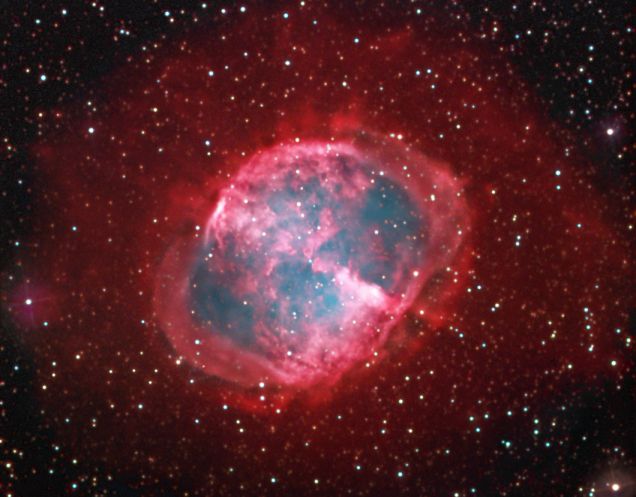Credit & Copyright: Robert Gendler
Explanation:
In 1764, French astronomer
Charles
Messier sighted this gorgeous
cosmic cloud which
he
described as an oval nebula without stars.
Cataloged as M27,
it is now popularly known as the
Dumbbell
Nebula, not for its substandard academic performance but
for the elongated shape, like a bar with weights on each end, which
first
caught Messier's eye.
This deep image of the bright planetary
nebula does reveal the Dumbell's central star though, and
an array of foreground and background stars
toward the sly constellation
Vulpecula.
The picture is
a composite
that includes 8 hours of
exposure through a filter designed to record only the light
of hydrogen atoms, tracing the intricate details of
the nebula's faint outer halo
which spans light-years.
Thought to be an example of the
fate awaiting our own
Sun 5 billion years hence, the Dumbbell Nebula is
about 1,200 light-years away.
1999 2000 2001 2002 2003 2004 2005 2006 2007 2008 2009 2010 2011 2012 2013 2014 2015 2016 2017 2018 2019 2020 2021 2022 2023 2024 2025 |
Yanvar' Fevral' Mart Aprel' Mai Iyun' Iyul' Avgust Sentyabr' Oktyabr' Noyabr' Dekabr' |
NASA Web Site Statements, Warnings, and Disclaimers
NASA Official: Jay Norris. Specific rights apply.
A service of: LHEA at NASA / GSFC
& Michigan Tech. U.
|
Publikacii s klyuchevymi slovami:
M 27 - planetary nebula - dumbbell nebula - Planetarnaya tumannost' - Tumannost' Gantel'
Publikacii so slovami: M 27 - planetary nebula - dumbbell nebula - Planetarnaya tumannost' - Tumannost' Gantel' | |
Sm. takzhe:
Vse publikacii na tu zhe temu >> | |
